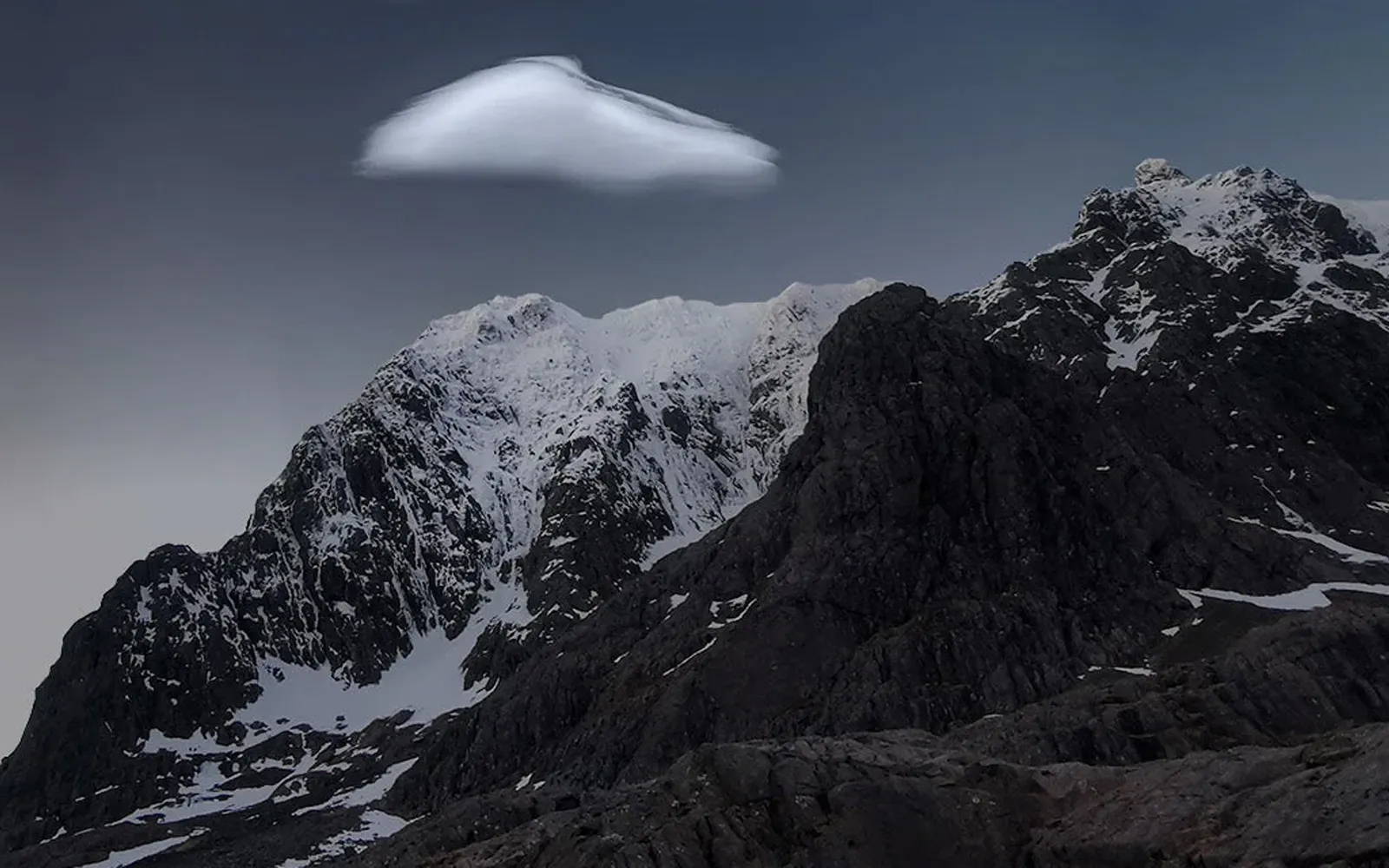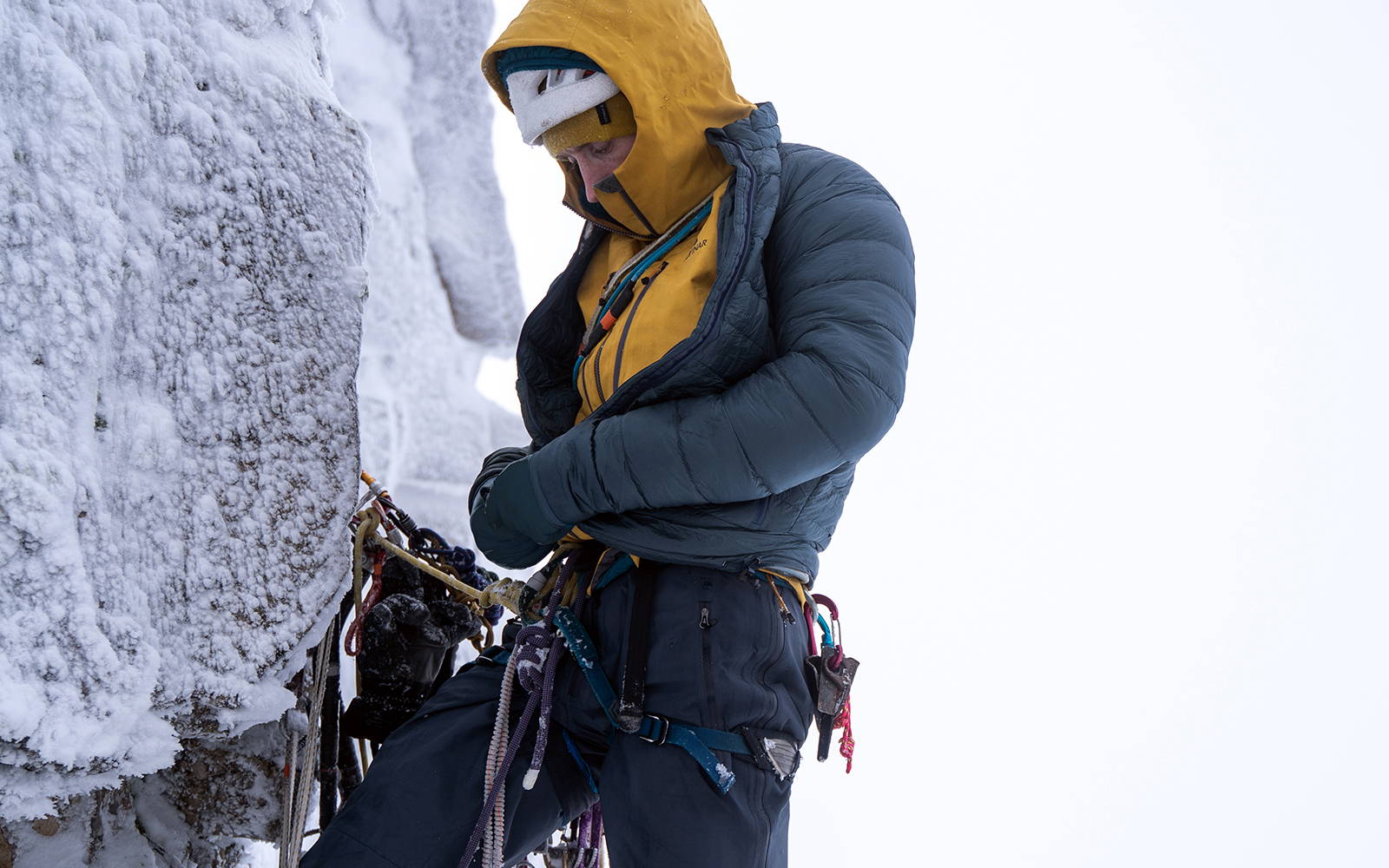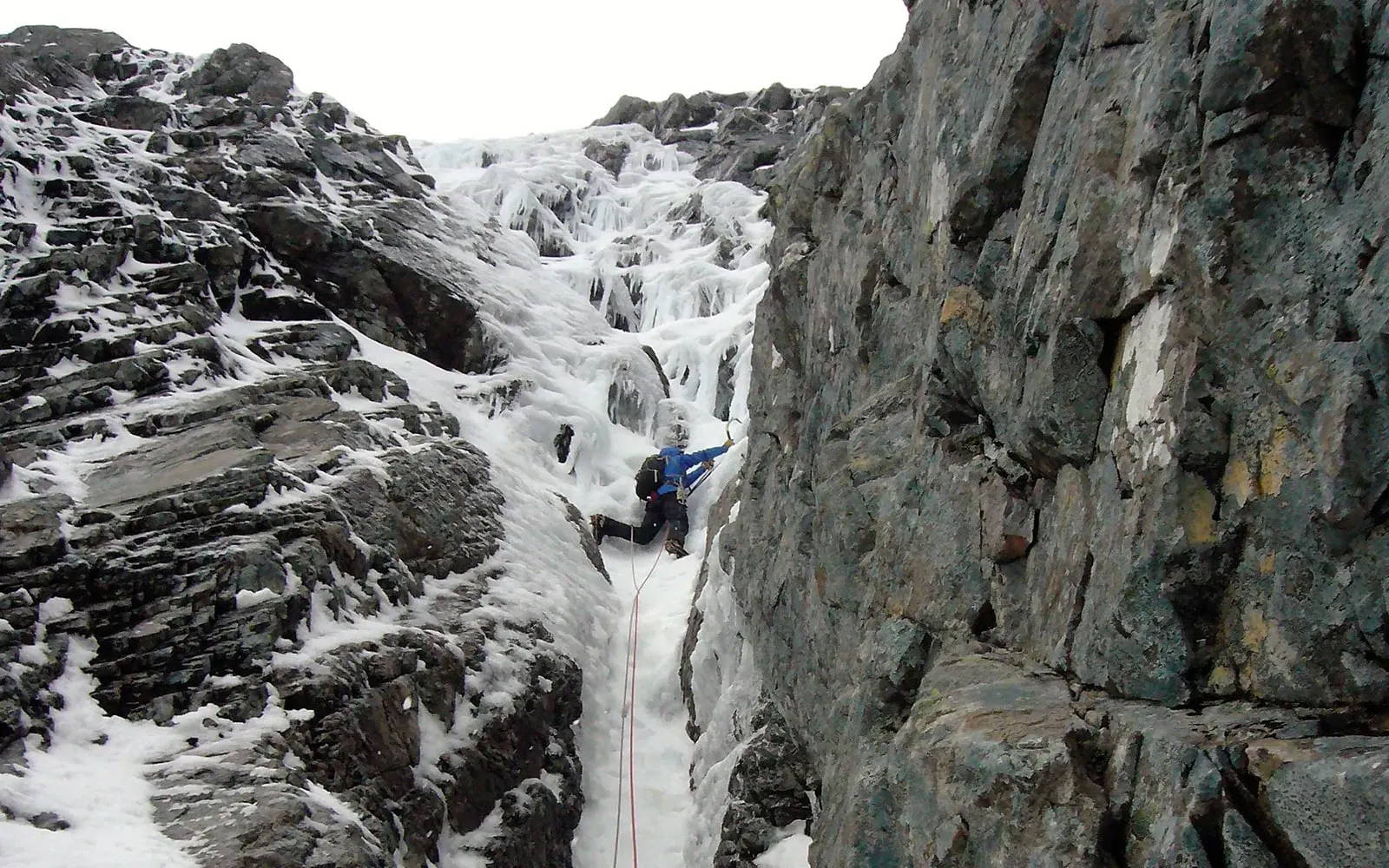
Mike Pescod
JÖTTNAR PRO TEAM
Mike is an IFMGA mountain guide, accomplished winter climber and member of the Jöttnar Pro Team. He operates Fort William-based Abacus Mountain Guides, providing skills training and mountain guiding in Scotland and the Alps.
Moving up to the next grade in winter climbing can feel like a daunting prospect. Much of the time the barrier is in the mind, but there are some specific practical steps you can take. Mike Pescod of the Jöttnar Pro Team explains.
1. Protection
As winter climbing gets harder, placing gear also gets harder. Practice getting used to placing protection on harder climbs in more difficult positions when you’re climbing at your current grade. You can do this by placing protection in tricky places: just try to stop on the steeper, harder sections and place some gear. Don’t power through the crux; stop halfway through it instead and place an ice screw or a nut. This will give you practice in placing protection in more difficult places, which is what it will feel like on harder climbs. Make sure you are relaxed and slick at placing the protection. If it does not work you can just carry on climbing like you would have done anyway.
In fact, even if you don’t place protection, stopping halfway through the tricky section of a climb at your current grade is a good idea. Instead of powering through to easier ground above, slow down and admire the view. You need confidence in what you are doing and in the position you are in. If you are rushing though the crux, you’re not ready to move up a grade. If you are relaxed and confident enough to stop and soak up the atmosphere, then you are almost certainly ready to try a harder climb.
High on the Ben Nevis classic, Gargoyle Wall.
A double ice screw belay on The White Line, Ben Nevis.
" YOU NEED CONFIDENCE IN WHAT YOU ARE DOING AND THE POSITION YOU ARE IN. "
At the same time, you need to trust your protection and belay anchors; you might even need to do a hanging belay on a harder route. So practice and get confident in your anchors by leaning out on your anchors when you are belaying your buddy. This is a good idea anyway. You do not want any slack rope between you and your anchors if you are belaying off your harness, so that there is no chance of a shock load on your anchors if your buddy falls off. So kick out a nice ledge, stand tall and lean back on your anchors with confidence.
2. Research
Do your research. Winter climbs come in all shapes and sizes, styles and characters. Choose one that matches your strengths, whether it is ice, mixed, or snowed-up rock. Find out what it takes to be in optimum condition, where the pitches go, where to belay and where the crux is. Choose a popular climb which is well known, not an esoteric adventure that has only seen one ascent. Make sure it is well known so you can get the information you need and so you know the grade is accurate. You will also be able find out when it has been climbed recently. Despite this, it can still be tricky working out what the optimum conditions are for your chosen route. The information is much more available these days, though, and don’t be afraid to ask around.
Snowed up rock climbs often come in to condition first each winter. These are solid rock climbs that just need a quick freeze along with rime and snow to make the rocks white. Savage Slit and Fallout Corner in the Northern Coires of Cairngorm, Slab Route on Ben Nevis, Scabbard Chimney and Crest Route on Stob Coire nan Lochan are all pretty good examples.
Jöttnar co-founder Tommy Kelly enjoys superb winter climbing conditions on Gargoyle Wall, Ben Nevis.
Getting on the right route at the right time is crucial to successful Scottish winter climbing.
Mixed routes take a little longer to freeze up properly and should not be attempted until the turf is frozen solid. These routes are climbed on rimed up rock, frozen turf and bits of ice all mixed up together. Climbing mushy turf is very unpleasant and damages the turf for future ascents. Taliballan on Stob Coire an Laoigh in the Grey Coires, Western Chimney Route on Bidean nam Bian and Morwind on Aonach Mor are all good examples of turfy mixed climbs.
Some mixed climbs take a bit more frozen snow-ice to be at their best. Snow-ice is formed by snow on the route being warmed by a thaw so that it goes wet but does not melt away, then refreezing into solid, aerated ice that is brilliant to climb on. Thompson’s Route on Ben Nevis is just like this. It’s a wonderful icy mixed route with bits of snow-ice and bits of rock in a chimney. It’s a dream to climb when the snow-ice has built up properly, but very tricky beforehand.
When the snow-ice has had more time to form and just the right combination of snowfall and thaw freeze cycles (often not until February or March) Scotland’s West Coast classic ice climbs can be at their best. Orion Direct, Hadrian’s Wall Direct, Point Five Gully and Zero Gully are all climbs to aspire to once you are confident on grade V ice and you can climb 300m or 400m in a few short hours!
" INFORMATION IS MUCH MORE AVAILABLE THESE DAYS, DON'T BE AFRAID TO ASK AROUND. "
When we get a sharp cold snap there are ice climbs that form in natural drainage lines. Whole venues such as Beinn Udlaidh is a perfect example of a venue full of ice climbs that require a very good freeze of a week or two but very little snow or thaw freeze cycles. The climbs here are of strong but hard water ice that is secure to climb on (solid ice screws as well as ice axe placements) but steep and hard work to place your picks. Make sure you sharpen your picks and crampons before you go.
Some winter climbs are good in any conditions and it is well worth knowing about these. If you climb the same route in very different conditions you will learn about how the conditions change the climbing and the feel of the route. It might also give you some good climbing in marginal conditions or bad weather. North Buttress on Buachaille Etive Mor is a great example. The grade is much the same if it is just rimed up, buried on soft snow or if it has a line of ice in the chimney and it is always great fun. The South West Ridge of Douglas Boulder on Ben Nevis has become a very popular climb recently for the same reasons.
Heading for the Ben Nevis classic Minus Two Gully in a semi-whiteout.
In the belly of Crypt Route. Bidean nam Bian, Glencoe.
3. Experience
Try to climb with climbers who are better than you. You will find it easier to move up a grade if you have seconded a few climbs at that grade and know what the climbing feels like. In fact, if you can get a buddy to lead you up a climb that you want to lead yourself you will have much more chance of success. Much of the difficulty in moving up a grade is psychological, so take away the concerns over route finding, where to belay, what kind of protection to take with you as well as the climbing itself by climbing it with a stronger climbing buddy. Even though leading a route you have seconded makes it much easier to lead, you will still have the confidence of having lead at that grade which will carry you forward to your first onsight lead of that grade.
Serve an apprenticeship and move through the grades steadily. If you climb just one grade IV route you are not automatically ready to climb a grade V. Even if you find the grade IV straightforward you should climb several more at that grade before moving up the grade. Experience is earned through spending time on lots of climbs in different locations, on different days and in different conditions. You learn how to deal with many, many different situations and these help you cope with new situations that you will undoubtedly face.
" IF YOU CLIMB JUST ONE GRADE IV ROUTE, YOU ARE NOT AUTOMATICALLY READY TO CLIMB A GRADE V. "
There is more to ice climbing than climbing ice: in fact, the techniques of winter climbing are only a small part of climbing winter routes. Be prepared to build up a huge bank of experience by climbing lots and lots of routes. You will learn all sorts of tricks from other climbers, about dealing with the harsh weather, about how the weather affects the climbing conditions, about avalanche safety and navigation, and about how to cope when everything doesn’t go right.
There is more to ice climbing than climbing ice.
Mike Pescod in classic Scottish winter conditions.
4. System
Sort your system so that you stay warm and dry. We all have different preferences of gloves and clothes but a system that works well for you is essential. It’s easy to become cold, hungry and dehydrated in the mountains, and all these will dramatically reduce your performance. Play around with different gloves and carry spares for when you get wet. Use a belay jacket; you can take one between the two of you if you are swinging leads. Take a hardshell jacket that fits over your helmet, does not pull out from under your harness, and does not hang over your harness covering up your gear: this makes a huge difference to your climbing.
Take food that is easy to eat on a belay ledge, and a hot flask that you can drink from easily. If you can arrive at the foot of the crux pitch feeling warm, dry and well fed you will be in a much better position to climb it. The concept of marginal gains developed by British cycling coach Dave Brailsford really makes sense in winter climbing. Something as simple as making sure your zips are done up, for example, can really help you take your climbing to the next level.
Mike Pescod is a member of the Jöttnar Pro Team. Find out more here.



